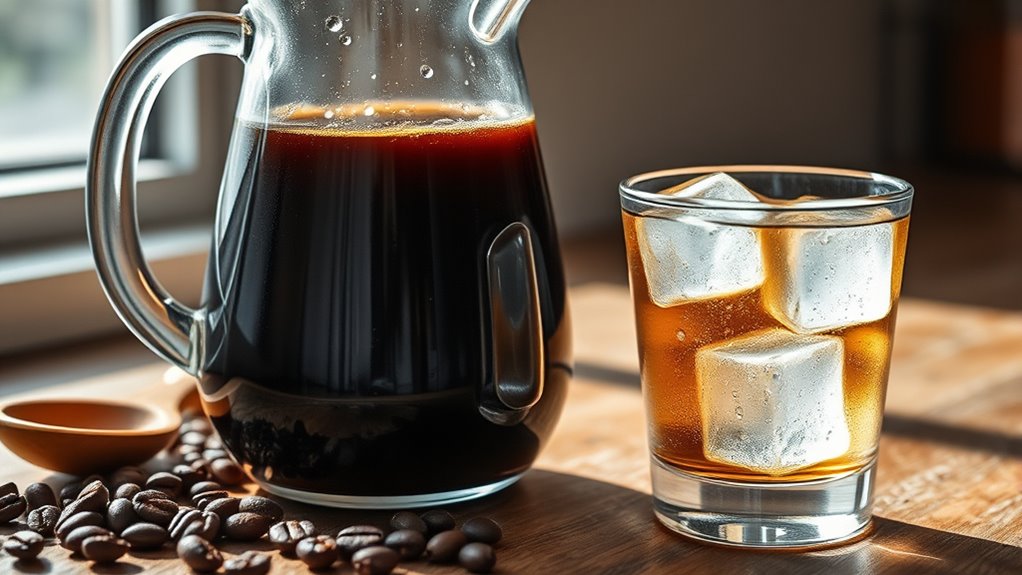Mastering cold brew coffee at home is easy and rewarding. You’ll start by coarsely grinding fresh coffee beans, mixing them with filtered water at a 1:2 ratio, and allowing the steeping process to occur for 12 to 24 hours. This method creates a smooth, less acidic drink that’s gentle on your stomach. You can customize your cold brew to your taste, and when you follow our tips, you’ll reveal even more delicious possibilities.
Key Takeaways
- Use coarsely ground coffee beans with a 1:2 coffee-to-water ratio for optimal flavor extraction in your cold brew.
- Steep the mixture at room temperature for 12 to 24 hours, aiming for around 20 hours for the best taste.
- Strain the coffee through a fine mesh strainer lined with cheesecloth or paper filters to achieve a smooth finish.
- Store your cold brew concentrate in an airtight container in the fridge for up to two weeks for convenient enjoyment.
- Experiment with different milk or water ratios and recipes to customize your cold brew experience to your taste preferences.
Understanding Cold Brew Coffee

When you plunge into the world of cold brew coffee, you’ll discover a unique brewing method that sets it apart from traditional coffee. This process involves steeping coarsely ground coffee beans in filtered water for an extended period, typically 12 to 24 hours.
The long steeping time allows the flavors and caffeine to extract efficiently, resulting in a smooth, less bitter taste. Unlike iced coffee, which is brewed hot, cold brew coffee offers a sweeter profile due to its slow infusion.
The recommended coffee-to-water ratio is 1:2; for every 1 ½ cups of coffee grounds, use 3 cups of water. Once you make cold brew concentrate, you can store it in the fridge for up to two weeks, ensuring you’ve always got a revitalizing option on hand.
How to Make Cold Brew Coffee

Making cold brew coffee is a straightforward process that can elevate your coffee experience.
Start by coarsely grinding fresh coffee beans, using a 1:2 coffee-to-water ratio—like 1 ½ cups of coffee for every 3 cups of cold, filtered water.
Combine the coarsely ground coffee with water in a brewing container and stir gently to saturate all the grounds. Let it steep at room temperature for 12 to 24 hours for ideal flavor extraction.
After steeping, strain the mixture through a fine mesh strainer lined with cheesecloth or paper filters to separate the coffee grounds from the brewed concentrate.
Store your cold brew coffee concentrate in an airtight container in the refrigerator.
When ready, adjust the strength and serve over ice for a revitalizing drink!
Tips for Brewing Cold Brew Coffee

Once you’ve mastered the basics of making cold brew coffee, it’s time to refine your brewing technique with some helpful tips.
Start by using a coarse grind for your coffee beans; this prevents over-extraction and gives you a smooth flavor. Aim for a steeping time of around 20 hours at room temperature to develop ideal taste.
Don’t forget to use filtered water, as it enhances the flavor and quality of your cold brew at home. Experiment with the coffee-to-water ratio, starting with 1:2 (1 ½ cups of coffee to 3 cups of water), and adjust according to your preferences. Additionally, understanding the mechanics of French press can help improve your overall brewing skills, even in cold brew preparation.
Finally, store your brewed coffee in an airtight container in the refrigerator, where it’ll stay fresh for up to two weeks.
Recipe Overview and Batch Preparation

Cold brew coffee is simple to prepare, and with just a few ingredients, you can create a delicious and invigorating beverage.
Start by combining 1 ½ cups of coarsely ground coffee with 3 cups of cold, filtered water, using a 1:2 coffee-to-water ratio for a strong concentrate.
After about 10 minutes of prep time, let it steep for at least 12 hours—ideally around 20 hours—for the best flavor.
Once steeped, strain the mixture using a fine mesh strainer lined with cheesecloth or paper filters to separate the coffee grounds.
Store your cold brew concentrate in an airtight container in the fridge for up to two weeks.
When you’re ready to enjoy, dilute with water or milk to suit your taste!
Brewing Comparisons and User Engagement

When you compare cold brew to traditional coffee, you might notice its smoothness and lower bitterness.
Sharing your experiences can spark discussions about brewing techniques and favorite ratios, helping everyone refine their craft.
Let’s explore how your preferences shape the cold brew journey and connect with fellow coffee enthusiasts!
Taste Test Comparisons
How do you decide between cold brew and traditional iced coffee? Conducting side-by-side taste tests can help you discover which suits your palate better.
Cold brew usually offers a smoother flavor profile with less bitterness, making it appealing if you prefer milder coffee. When you use freshly ground coffee beans, you’re likely to experience a richer flavor and aroma.
Plus, many coffee lovers appreciate cold brew for its low acidity, which is easier on the stomach. Experimenting with different coffee-to-water ratios during these taste tests allows you to find your ideal strength and balance.
This customizable option makes cold brew an exciting choice for everyone, inviting you to refine your brewing techniques and personal preferences.
User Experience Sharing
What makes the experience of brewing cold brew coffee so engaging for users? It’s the opportunity to explore and refine your personal taste. Cold brew coffee stands out for its smoothness and richer flavor profile compared to traditional iced coffee.
By experimenting with freshly ground coffee beans and adjusting your coffee-to-water ratios, you can achieve that perfect balance.
- Steeping times can vary, with many users suggesting anywhere from 12 to 24 hours for ideal flavor.
- Engaging with others in discussions about their brewing experiences fosters a sense of community.
- Sharing tips and challenges makes the cold brewing journey more enjoyable and rewarding.
Dive into this world, and you’ll discover endless possibilities for your cold brew coffee.
Brewing Technique Discussions
While many coffee lovers are familiar with traditional brewing methods, diving into cold brew techniques opens up a new domain of flavor exploration. Cold brew coffee, steeped in cold or room temperature water for 12 to 24 hours, yields a smoother, less bitter taste compared to hot coffee. As an added bonus, many local roasters emphasize ethical sourcing practices to ensure high-quality beans for your brew.
Engaging with fellow enthusiasts can enhance your experience. Check out the table below for a quick reference on brewing comparisons:
| Brewing Method | Flavor Profile |
|---|---|
| Cold Brew | Smooth, Sweet |
| Iced Coffee | Bright, Bitter |
| Hot Brew | Bold, Acidic |
| Concentrate | Strong, Rich |
Experimenting with coffee beans and water ratios can drastically change your cold brew. Additionally, understanding how caffeine affects sleep can help you decide when to enjoy your cold brew. So, get brewing and enjoy!
Cold Brew System and Preparation

To create a rich and flavorful cold brew, using the Toddy Cold Brew System is a smart choice. This system allows you to make cold brew effortlessly, combining one pound of coarsely ground coffee with nine cups of water for a robust concentrate.
Remember to secure the rubber stopper during the brewing process to avoid spills.
- Steep for 18-24 hours for ideal flavor development.
- After steeping, drain the mixture into a carafe for several hours.
- Consider a second steeping with additional water for more cups of coffee.
Dispose of old coffee grounds properly, and rinse the cloth filter without soap, storing it in the fridge to maintain its flavor integrity.
Enjoy your fresh, strained coffee!
Steeping Process and Cleanup

Once you’ve steeped your coffee mixture for 18-24 hours, it’s time to focus on the cleanup process.
Start by removing the rubber stopper from your Toddy Cold Brew Maker, allowing the coffee concentrate to flow into a carafe. This may take several hours due to the fine filter.
If you want a stronger flavor, consider a second steeping with additional water on the used grounds.
Once drained, store your coffee concentrate in an airtight container in the refrigerator, where it’ll stay fresh for up to two weeks.
For cleanup, rinse the cloth filter thoroughly, avoiding soap to maintain flavor integrity.
Store the filter in the fridge when not in use, replacing it every 3-6 months for ideal performance.
Cold Brew Recipes

Cold brew coffee isn’t just a rejuvenating drink; it’s a canvas for creativity. You can easily make a big batch and customize it to suit your taste.
Here are a few invigorating recipes to try:
- Iced Cold Brew Flat Latte: Mix 3 oz of cold brew with 9 oz of milk and flavored syrup over ice for a creamy treat.
- Iced Cold Brew Americano: Combine 3 oz of cold brew with 6-12 oz of water over ice for a robust flavor.
- Dirty Chai Cold Brew Latte: Let chai tea steep in milk before mixing it with cold brew for a spicy twist.
Pour the coffee, add milk and flavored syrup, and enjoy your great coffee creations!
Benefits and Cost-Effectiveness of Cold Brew Coffee

There’s no denying that cold brew coffee offers both delicious flavor and impressive cost savings. By making it homemade, you can enjoy a cost-effective beverage that costs as little as five cents per cup, compared to at least $3 at cafes.
Preparing large batches allows your cold brew to last up to two weeks, providing convenience and reducing your need for frequent purchases. Plus, with minimal ingredients required, brewing at home is accessible and economical.
Cold brew’s smoother, less acidic profile appeals to many, making it a versatile choice for various coffee recipes. Additionally, opting for homemade cold brew supports sustainability by cutting down on disposable cups and K-cups, enhancing both your coffee experience and environmental impact.
Frequently Asked Questions
How to Make Better Cold Brew at Home?
To make better cold brew at home, start with a coffee-to-water ratio of 1:2, using 1 ½ cups of coarsely ground coffee for every 3 cups of cold, filtered water.
Steep the mixture at room temperature for 12 to 24 hours, aiming for about 20 hours for ideal flavor.
Use a burr grinder for consistent coarseness, and store your concentrate in an airtight container in the fridge to maintain freshness.
Experiment with flavors to customize!
What Is the Perfect Ratio for Cold Brew Coffee?
The perfect ratio for cold brew coffee really depends on your taste. A standard starting point’s 1:4, meaning one part coffee to four parts water.
If you like it stronger, try a 1:2 ratio, which makes a more concentrated brew. For a milder flavor, increase the water or decrease the coffee.
Don’t hesitate to experiment; adjusting the ratio lets you find what suits your palate best. Enjoy the process!
Can I Make Cold Brew With Regular Coffee Grounds?
Yes, you can make cold brew with regular coffee grounds, but you might want to contemplate coarsely ground coffee. It helps prevent over-extraction and that gritty texture.
Store-bought pre-ground coffee may lack freshness, which can affect flavor. Aim for a coffee-to-water ratio of 1:2, letting it steep for 12 to 24 hours at room temperature.
Don’t hesitate to experiment with different roast levels and grind sizes for a smoother experience!
How Long Should I Let Cold Brew Steep?
You should let your cold brew steep for at least 12 hours to guarantee ideal flavor extraction.
However, if you want a richer brew, steeping for 18-20 hours is often the sweet spot.
Going longer than 24 hours might make it taste bitter, while less than 12 hours can result in a weak flavor.
Always steep at room temperature for the best results, as brewing in the fridge can lead to a flat taste.
Conclusion
Mastering cold brew coffee at home isn’t just for baristas; it’s for anyone who loves a smooth, rich cup. You might think it’s too complicated, but with a few simple steps, you can create your own delicious brew effortlessly. Imagine waking up to a invigorating cold brew, perfectly tailored to your taste, without the cafe price tag. So grab your coarsely ground coffee and start experimenting—you’ll soon wonder how you ever lived without it!









